
|
|||||||||||||||||||
Baked goods & pasta
 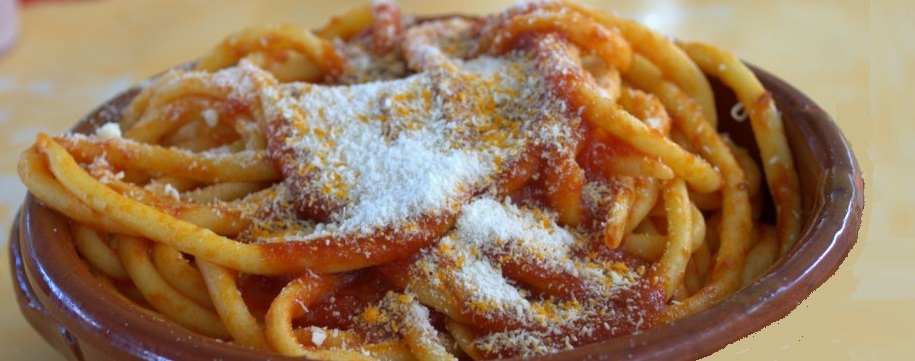 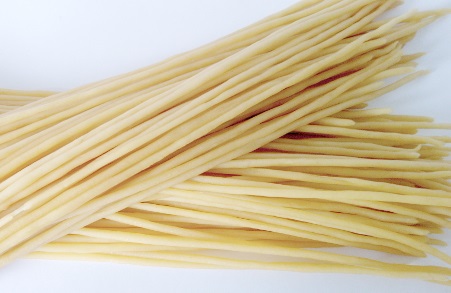 Fusillo di Felitto - U’ fusillu made in Felitto, close to Salerno, is a hollow pasta cilinder, 18 to 22 cm long, handmade with eggs, flour, salt, water, olive oil and a 4 faced iron tool. Fusillo di Felitto - U’ fusillu made in Felitto, close to Salerno, is a hollow pasta cilinder, 18 to 22 cm long, handmade with eggs, flour, salt, water, olive oil and a 4 faced iron tool.The legend of its ancient origins says that in the 16th century, during a siege where the townsfolk had been resisting for 10 days, the commander asked the women to cook something with what was available, so they prepared the “Fusillo di Felitto” with eggs and flour for the first time. For sure the production is centuries old and has been passed down from mother to daughter till today where it represents the typical dish during the special festivities of Felitto. Today product has passed from homemade goods to artisan production; it requires a special skill which only the women of Felitto possess. Famous restaurants in Paestum have to order them straight from the ladies of Felitto to include them in their menus. 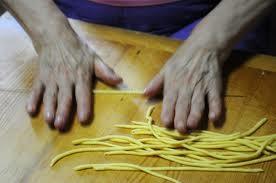 Fusillo di Gioi - a handmade 12 to 15 cm long linear pasta. Likewise the fusillo di Felitto, the origins are part of a traditional legend. Fusillo di Gioi - a handmade 12 to 15 cm long linear pasta. Likewise the fusillo di Felitto, the origins are part of a traditional legend.It is said that during the 10th century the townsfolk from Gioi hung the dough made of flour and eggs to their rifles through the castle wall slits during sieges to show the Arabs that they possessed plentiful supplies and wouldn’t surrender. Still today the fusillo is made preparing a piece of pasta around an iron stick; when it’s removed it leaves the whole length of pasta hollow so that the sauce sticks to the fusilli from the inside as well as the outside giving it its characteristic flavor. 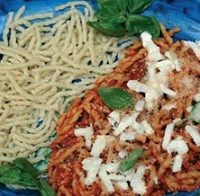 Fusillo Furitano - The “ricci” or “riccioli”, also known as “fusilli furitani” when longer, are a specialty of the Amlafi coast and Minori, in the Salerno area. Kneading is made on a table with a mound of flour with a whole in the center where all the ingredients are energetically kneaded at length. Fusillo Furitano - The “ricci” or “riccioli”, also known as “fusilli furitani” when longer, are a specialty of the Amlafi coast and Minori, in the Salerno area. Kneading is made on a table with a mound of flour with a whole in the center where all the ingredients are energetically kneaded at length. The production is over a hundred years old and still continues to preserve the manual ability obtained through experience. It’s a widely used and very tasty pasta, that goes well with meat and seafood sauces but also with a simple tomato sauce. Ricci are still homemade following the tradition but can be found in shops in Minori as well as in restaurants with sausage ragù sauces.
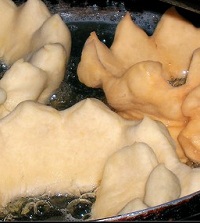 Guanto Caleno - It’s a golden yellow cake shaped like a doughnut made of soft and delicate dough. The recipe’s origin is uncertain but no doubt it is very ancient and has being passed down verbally through the years. Guanto Caleno - It’s a golden yellow cake shaped like a doughnut made of soft and delicate dough. The recipe’s origin is uncertain but no doubt it is very ancient and has being passed down verbally through the years.Still today production of this particular cake is guarded by a small group of women in a communal ritual that follows the ancient traditions. Custom wants that in some particular religious festivities such as baptisms, christenings or weddings, the “guanto caleno” is commissioned to these female custodians of the ancient tradition. You can’t normally buy it in local shops for it’s only sold to support local festivities or to gather offerings for poor people. It’s prepared with flour, sugar, milk, olive oil, yeast, anisette and grounded lemon peel. In the past, bicarbonate soda was used instead of yeast. Ingredients are mixed in the bread chest and after resting for half an hour the dough is spread on a wooden table and the pastry, half a cm thick, is cut into large 5 cm wide ribbons with an iron tool made by local craftsmen. It is made into high rings and immediately fried in vegetable oil. Its distribution is limited to Calvi Risorta and some nearby towns. 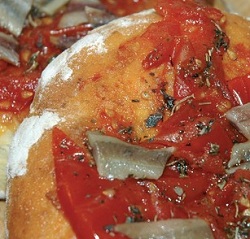 During the celebrations for Santa Chiara in Naples, a kind of pizza called “pagnotta di Santa Chiara” is made to honour the saint. During the celebrations for Santa Chiara in Naples, a kind of pizza called “pagnotta di Santa Chiara” is made to honour the saint. A small folded pizza made of flour, mashed potatoes, yeast, lard and pepper is kneaded together by hand and left to rise for about 2 hours. Tomatoes and sardines are cooked separately together with oregano and parsley and are used for the stuffing.
Cooked in the open wood fire ovens, this pizza used to be made at home but now they can be found also in the typical fried food shops of Naples’s historical center.
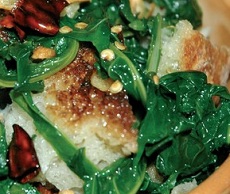 Pancotto dei Foresi - “Furisi” are namely “those who live outside”, traveling cattle breeders that live in the open, and give the name to this dish in the area of Alta Valle del Calore near Avellino. Pancotto is a poor but substantial dish, the main meal consumed traditionally by travelling cattle breeders. Pancotto dei Foresi - “Furisi” are namely “those who live outside”, traveling cattle breeders that live in the open, and give the name to this dish in the area of Alta Valle del Calore near Avellino. Pancotto is a poor but substantial dish, the main meal consumed traditionally by travelling cattle breeders. It’s made of old bread cooked in a “callarulo”, a big pot that boils turnip heads and other vegetables, like asparagus, cicoria heads, vitalba or potatoes. After boiling this soup made of bread and vegetables, the water is drained. In another pan, oil, big pieces of garlic, hot chillies are stir fried and then gradually added to the bread and vegetable soup till it’s perfectly oiled.
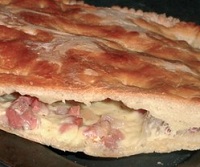 Pizza “chiena”, that means “full”, from Irpinia is, as the name suggests, a richly filled pizza. The origins are difficult to find, but it’s a country dish for sure. Pizza “chiena”, that means “full”, from Irpinia is, as the name suggests, a richly filled pizza. The origins are difficult to find, but it’s a country dish for sure. It was created by the need of having a complete meal, very nutritional and made of inexpensive ingredients. It’s a delicious variation of homemade bread, filled with spicy sausages, lard and scamorza. Pizza chiena is made at home and baked in wooden fire ovens and can be bought in workshops around Avellino, Benevento, Caserta and Salerno (”Tasca”).
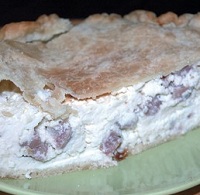 "Pizza cu la ricotta "is a speciality of the areas around Alta and Media Valle del Calore, in Avellino’s district. This area is characterized by the high quality of the sheep and cow ricotta as well as different kinds of salami, such as salsiccia and soppressata. "Pizza cu la ricotta "is a speciality of the areas around Alta and Media Valle del Calore, in Avellino’s district. This area is characterized by the high quality of the sheep and cow ricotta as well as different kinds of salami, such as salsiccia and soppressata. These are the ingredients that represent the heart of this filled pizza, the dough instead is rolled out and filled of soft grain flour, suet or oil, salt, eggs and a bit of water. After being rolled out, it’s filled with a stuffing made of sheep and goat ricotta, eggs and pieces of sausages and prosciutto. Then the pizza is baked in the oven. It’s a very ancient dish, the recipe is well known in every home.
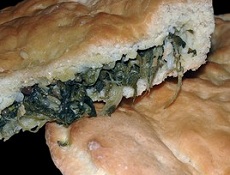 Pizza di scarola - Traditionally, pizza di scarola, used to be a Neapolitan Christmas Eve dish, when people tried to eat less to prepare for the next day’s feast. Today it’s prepared on many occasions, but still following the traditional recipe that uses scarola but even bietole da coste, known as “jeta”, so that it’s sometimes called “pizza con la jeta”. Pizza di scarola - Traditionally, pizza di scarola, used to be a Neapolitan Christmas Eve dish, when people tried to eat less to prepare for the next day’s feast. Today it’s prepared on many occasions, but still following the traditional recipe that uses scarola but even bietole da coste, known as “jeta”, so that it’s sometimes called “pizza con la jeta”. First you rinse and clean the scarola, a tasty vegetable of the indivia variety, grown in Campania. Once rinsed and dried the scarola is fried with a lot of oil and minced garlic or onion, hot chillies and a salted sardine. On the coast olives and capers are added. A bread dough is prepared to be used as a base and a cover for the scarola: the top part shall be curled on the sides and lightly pinched with a fork to make small holes. The pizza is baked in the oven until gold in colour. 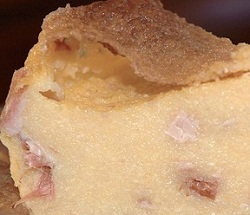 Pizza migliazza cu li frittole - Pizza migliazza cu li frittole is an authentic recipe from Irpinia: it’s a pizza to be done in the oven with a base made of cornflour, dressed with pecorino cheese and “frittole”, i.e. little pieces pork skin and fat made from lard. Probably Migliazza was made of semola, from which its name is derived. Semola was later substituted with cornflour. Pizza migliazza cu li frittole - Pizza migliazza cu li frittole is an authentic recipe from Irpinia: it’s a pizza to be done in the oven with a base made of cornflour, dressed with pecorino cheese and “frittole”, i.e. little pieces pork skin and fat made from lard. Probably Migliazza was made of semola, from which its name is derived. Semola was later substituted with cornflour. Migliazza is a winter dish considering the ingredients used, such as the left overs from pigs, and the high caloric value. It was traditionally made with the minestra maritata. The preparation is very simple: you just have to boil the frittole in water, salt hot pepper and add, once boiled, the cornflour and grinded pecorino cheese. The dough once cooked and amalgamated, is left to dry and then baked on a well greased pan in the oven; or it can be cooked in a covered pot on the barbecue with pieces of charcoal on the lid.
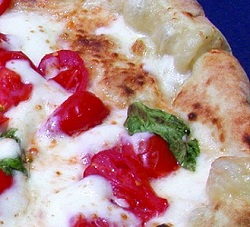 Pizza Napoletana Verace Artigianale - Pizza’s origins are very old and there’s many different and uncertain theories on its geographical place of origin and etymological meaning. What is certain is that Pizza reached its perfection in Naples, so that today “pizza” and “pizzeria” are the most known Italian words in the world. Pizza Napoletana Verace Artigianale - Pizza’s origins are very old and there’s many different and uncertain theories on its geographical place of origin and etymological meaning. What is certain is that Pizza reached its perfection in Naples, so that today “pizza” and “pizzeria” are the most known Italian words in the world. Pizza has become one of the city’s symbols. Although today there are many different kinds of dressings, the original Neapolitan pizza was created after the 18th century, and therefore after tomatoes were imported from America and, after been considered harmful for a while, started to be appreciated in cooking.
Tomatoes are the main ingredients of the real pizza, together with olive oil and oregano in the Marinara and olive oil, mozzarella and basil in the Margherita, the three coloured pizza invented in the 19th century to gratify Queen Margherita di Savoia. Very important as well are the ingredients for the dough: water, fresh beer yeast and sea salt. Pizza making is considered a work of art and Naples has earned its authorship.
Ravioli di ricotta di pecora also called “ravaiuoli” or “slim ravioloni” are an ancient traditional specialty of Campania: handmade ravioli filled with fresh sheep ricotta.
The dough is made with eggs and made at home in a ritual way: the outside pasta is made of tender grain flour, water, eggs and sea salt. Kneaded and then spread like pastry, it’s filled with ricotta, ground pecorino, herbs and aromas. In the end little stuffed half moons or circles are cut out with the help of a glass. The traditional sauce for the ravioli “di magro”, called thin because they’re meatless, is tomato ragù or lamb.
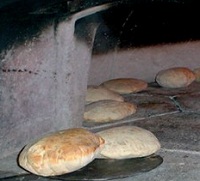 Sciusciello from Pellezzano, near Salerno, was once the principal local dish; today it is a traditional food which is celebrated in local summer festivities. It’s a tast bread made of wholemeal flour, salt, water and beer yeast, kneaded in a simple way, filled and baked in the oven. Sciusciello derives its name from “sciuscio”, the whispering sound that gas makes coming out of the holes on the puffed up bread’s surface. Sciusciello from Pellezzano, near Salerno, was once the principal local dish; today it is a traditional food which is celebrated in local summer festivities. It’s a tast bread made of wholemeal flour, salt, water and beer yeast, kneaded in a simple way, filled and baked in the oven. Sciusciello derives its name from “sciuscio”, the whispering sound that gas makes coming out of the holes on the puffed up bread’s surface. The bread is hollow inside and has an uneven surface. The colour is ash white with little dark spots made during the baking. Classic sciusciello is filled with lard and pepper, but the filling can vary with soft cheese, meat, salami, vegetables, chocolate, potatoes and whatever delights the more demanding palates.
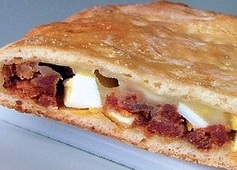 Tasca also known as pizzichini, pizzachiena or pizzaghiena is a gastronomic specialty from Salerno’s district and especially from the areas of Padula and Vallo di Diano. It’s a round, savoury pizza, 6-7 cm high, made of a thin external pastry made of flour, eggs, suet, salt, milk with baking soda and sugar. It’s filled with, sheep and cow fresh cheese, either grated or in pieces, fiordilatte, soppressata and boiled and beaten eggs. Tasca also known as pizzichini, pizzachiena or pizzaghiena is a gastronomic specialty from Salerno’s district and especially from the areas of Padula and Vallo di Diano. It’s a round, savoury pizza, 6-7 cm high, made of a thin external pastry made of flour, eggs, suet, salt, milk with baking soda and sugar. It’s filled with, sheep and cow fresh cheese, either grated or in pieces, fiordilatte, soppressata and boiled and beaten eggs. Following the ancient recipe, the dough is finished with a brush of beaten egsg and unrefined sugar before baking it. This very ancient recipe has arrived through oral tradition because tasca is still exclusively produced at home during Easter time. Traditionally consumed on Holy Saturday after the singing of the “Glory” and made in different shapes and sizes, even small ones for children.
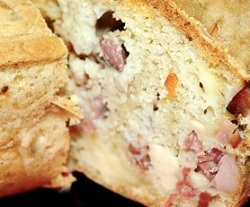 Casatiello sugno and pepe - The word “casatiello” probably derives from the distortion of the Neapolitan dialect word “cacio”, which is a type of cheese, and the grated cheese is one of its main ingredients. It’s the main Easter treat, ever present in every picnic basket on Easter Monday. A savory cake made of flour, lard, eggs, yeast, a lot of grated pecorino and some parmesan cheese filled with salami and pepper. Stuffing is traditionally salami and diced pieces of pork fat but there are variations like mortadella salami cubes and ham. The dough is kneaded by hand and left to rise for about 10 hours and then is cooked in the oven, preferably a wood fire oven. It’s round-shaped, and the original recipe includes boiled eggs inserted on the top. Casatiello is prepared in every Neapolitan house during Easter, but can even be bought in local bakeries. Casatiello sugno and pepe - The word “casatiello” probably derives from the distortion of the Neapolitan dialect word “cacio”, which is a type of cheese, and the grated cheese is one of its main ingredients. It’s the main Easter treat, ever present in every picnic basket on Easter Monday. A savory cake made of flour, lard, eggs, yeast, a lot of grated pecorino and some parmesan cheese filled with salami and pepper. Stuffing is traditionally salami and diced pieces of pork fat but there are variations like mortadella salami cubes and ham. The dough is kneaded by hand and left to rise for about 10 hours and then is cooked in the oven, preferably a wood fire oven. It’s round-shaped, and the original recipe includes boiled eggs inserted on the top. Casatiello is prepared in every Neapolitan house during Easter, but can even be bought in local bakeries. Calzone is usually perceived as a variation of the classic round pizza but according to some it represents its forefather, since the first news about pizza goes way back and it consisted in a thick dough covered with flavourings, folded in two and cooked on heated stones: indeed it was a calzone. Calzone is usually perceived as a variation of the classic round pizza but according to some it represents its forefather, since the first news about pizza goes way back and it consisted in a thick dough covered with flavourings, folded in two and cooked on heated stones: indeed it was a calzone. The Calzone, also known as “ripieno”, is served today in every Neapolitan pizzeria and is a kind of folded pizza. The dough is the same of the pizza, made of white flour, water, beer yeast and salt, and filled, according to the original recipe, with ricotta, dices of pork fat and black pepper then baked for a few minutes in a wood fire oven. There are many variations of the “classic” calzone mostly regarding the filling which has evolved in time: often the ripeno is served with mozzarella, basil, tomato and other types of salami.
Any question? - Do you enjoy Italian cooking?
Would you have a recipe you might want to share with us? La vetrina ideale per promuovere i vostri prodotti e servizi sul mercato Nord Americano ma che potrebbe essere un punto di visibilità anche nei vari mercati internazionali.
AZIENDE - PRODUTTORI - STRUTTURE RICETTIVE - GUIDE TURISTICHE - TOUR OPERATORI Ai nostri visitatori piace il Sud Italia, vuoi dire loro qualcosa? Il nostro obiettivo e' quello di promuovere prodotti tipici del Sud in un contesto di marketing globale, e allo stesso tempo proporre il nostro Meridione come alternativa turistica, ben consapevoli che il successo dell'uno è essenziale per il successo dell'altro. Paesi di provenienza dei visitatori in ordine numerico Stati Uniti - Canada - Italia - Gran Bretagna - Australia - China - Germania - Francia - Nuova Zelanda - Olanda Coloro interessati ad inserire la loro attivita'/azienda/ nel sito
|
|||||||||||||||||||

